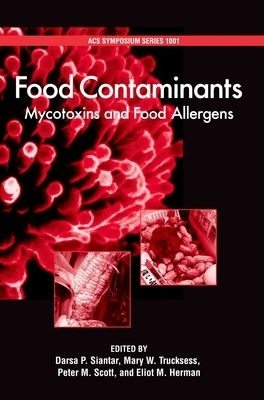
Food Contaminants
Mycotoxins and Food Allergens
Seiten
2008
Oxford University Press Inc (Verlag)
978-0-8412-6954-5 (ISBN)
Oxford University Press Inc (Verlag)
978-0-8412-6954-5 (ISBN)
- Keine Verlagsinformationen verfügbar
- Artikel merken
This book describes recent research progress on two commonly found food contaminants, mycotoxins and food allergens, and provides a contrast of their chemical nature, adverse effects, analysis, prevention and control.
Mycotoxins are secondary fungal metabolites. Several toxigenic fungi are pathogenic to cereal crops. Mycotoxins encompass a wide range of compounds, several of which have been shown to cause disease in domestic animals and, less frequently, in humans. The toxicology, prevention & control, and analytical methods are highlighted. Toxicology is represented by measurement of aflatoxin-DNA adducts as biomarkers of long-term risk of disease in people, mechanism of
fumonisin B1 carcinogenesis, and enhancement of ochratoxin A toxicity by citrinin. Attempts of mycotoxins control include preventing toxigenic fungi formation, decreasing toxins bioavailability, and facilitating toxins destruction. Monitoring mycotoxins occurrence and levels in commodities and foods is
crucial to divert contaminated materials from human and animal food supplies. Methods of analysis for mycotoxins include immunoaffinity columns, molecularly imprinted polymers, liquid chromatography-tandem mass spectrometry, and qualitative and quantitative lateral flow methods.
Food allergies limit the ability to consume foods without great caution and may be life-threatening. Increased government regulation and education is being used to address public concern on the rising food allergy rates. With the broad application of avoidance techniques through analysis, labeling, medical testing and possibly food modification, the rise in food allergy rates may be slowed and perhaps even reversed. While there are promising medical treatment developments it has had relatively
little impact in managing food allergy. At present there is little available preventive treatment with management being primarily avoidance of food and emergency treatment of severe adverse reactions. For the public, vigilance on food items is important, and for industry, a wide variety of controls,
including production and product line testing as well as labeling, are used to help the consumer make accurate avoidance choices. There are important issues of detection and threshold and using immunological and computer modeling to evaluate allergenic potential in food discussed in this book.
Mycotoxins are secondary fungal metabolites. Several toxigenic fungi are pathogenic to cereal crops. Mycotoxins encompass a wide range of compounds, several of which have been shown to cause disease in domestic animals and, less frequently, in humans. The toxicology, prevention & control, and analytical methods are highlighted. Toxicology is represented by measurement of aflatoxin-DNA adducts as biomarkers of long-term risk of disease in people, mechanism of
fumonisin B1 carcinogenesis, and enhancement of ochratoxin A toxicity by citrinin. Attempts of mycotoxins control include preventing toxigenic fungi formation, decreasing toxins bioavailability, and facilitating toxins destruction. Monitoring mycotoxins occurrence and levels in commodities and foods is
crucial to divert contaminated materials from human and animal food supplies. Methods of analysis for mycotoxins include immunoaffinity columns, molecularly imprinted polymers, liquid chromatography-tandem mass spectrometry, and qualitative and quantitative lateral flow methods.
Food allergies limit the ability to consume foods without great caution and may be life-threatening. Increased government regulation and education is being used to address public concern on the rising food allergy rates. With the broad application of avoidance techniques through analysis, labeling, medical testing and possibly food modification, the rise in food allergy rates may be slowed and perhaps even reversed. While there are promising medical treatment developments it has had relatively
little impact in managing food allergy. At present there is little available preventive treatment with management being primarily avoidance of food and emergency treatment of severe adverse reactions. For the public, vigilance on food items is important, and for industry, a wide variety of controls,
including production and product line testing as well as labeling, are used to help the consumer make accurate avoidance choices. There are important issues of detection and threshold and using immunological and computer modeling to evaluate allergenic potential in food discussed in this book.
Darsa Siantar is a senior scientist at the Alcohol & Tobacco Tax and Trade Bureau (TTB) under the U.S. Department of the Treasury. Mary W. Trucksess is the US Food and Drug Administration's principal authority on mycotoxins. Peter Scott received is a research scientist working on mycotoxins at Health Canada. Eliot Herman is a Research Molecular Biologist of the USDA Agricultural Research Service located at the Donald Danforth Plant Science Center in St. Louis.
| Erscheint lt. Verlag | 18.12.2008 |
|---|---|
| Reihe/Serie | ACS Symposium Series ; 1001 |
| Zusatzinfo | 2 colour, 23 halftones, 77 lines |
| Verlagsort | New York |
| Sprache | englisch |
| Maße | 159 x 236 mm |
| Gewicht | 860 g |
| Themenwelt | Medizin / Pharmazie |
| Naturwissenschaften ► Biologie ► Biochemie | |
| Naturwissenschaften ► Biologie ► Mykologie | |
| Naturwissenschaften ► Chemie ► Anorganische Chemie | |
| Technik ► Lebensmitteltechnologie | |
| ISBN-10 | 0-8412-6954-8 / 0841269548 |
| ISBN-13 | 978-0-8412-6954-5 / 9780841269545 |
| Zustand | Neuware |
| Haben Sie eine Frage zum Produkt? |
Mehr entdecken
aus dem Bereich
aus dem Bereich


